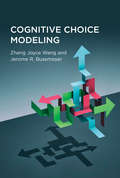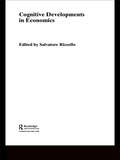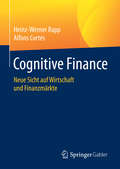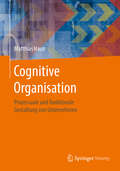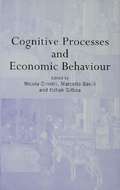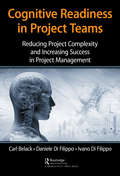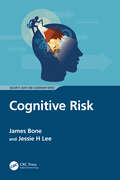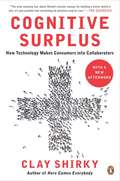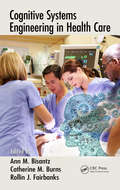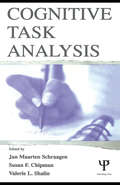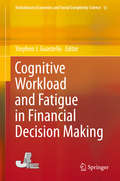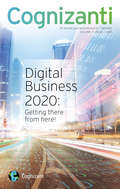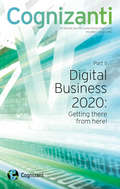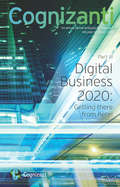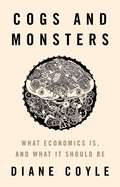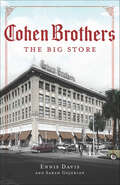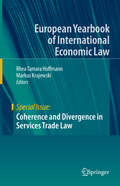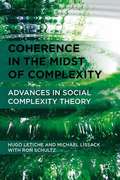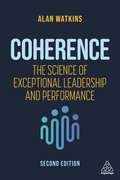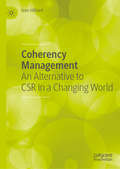- Table View
- List View
Cognitive Choice Modeling
by Jerome R. Busemeyer Zheng Joyce WangThe emerging interdisciplinary field of cognitive choice models integrates theory and recent research findings from both decision process and choice behavior.Cognitive decision processes provide the interface between the environment and brain, enabling choice behavior, and the basic cognitive mechanisms underlying decision processes are fundamental to all fields of human activity. Yet cognitive processes and choice processes are often studied separately, whether by decision theorists, consumer researchers, or social scientists. In Cognitive Choice Modeling, Zheng Joyce Wang and Jerome R. Busemeyer introduce a new cognitive modeling approach to the study of human choice behavior. Integrating recent research findings from both cognitive science and choice behavior, they lay the groundwork for the emerging interdisciplinary field of cognitive choice modeling.
Cognitive Developments in Economics (Routledge Frontiers Of Political Economy Ser.)
by Salvatore RizzelloCognitive Developments in Economics proposes an interdisciplinary approach to the study of human problem solving, choice, decision-making and change, to explain economic transactions, and the nature and evolution of organisations and institutions. The book contributes to a large spectrum of economic fields such as consumer theory, economics of the
Cognitive Finance: Neue Sicht auf Wirtschaft und Finanzmärkte
by Heinz-Werner Rapp Alfons CortésDieses Werk tr#65533;gt durch ver#65533;nderte Perspektiven, neuartige Methoden und einen bewusst interdisziplin#65533;ren Ansatz aktiv zur Erneuerung der traditionellen Wirtschafts- und Kapitalmarkttheorie bei. "Kapitalm#65533;rkte sind komplexe, adaptive und dynamische Systeme, die in hohem Ma#65533;e von menschlichen Wahrnehmungen und Verhaltensweisen abh#65533;ngen", so Heinz-Werner Rapp. Neue Erkenntnisse, etwa zu den Hintergr#65533;nden von Blasen und Crashs, lassen sich folglich nur durch Einbeziehung neuester Forschungsergebnisse aus dem Bereich der Neuro- und Kognitionswissenschaften gewinnen. Die "Cognitive Finance"-Methodik ist ein vom FERI Institut unter der Leitung von Dr. Heinz-Werner Rapp entwickelter Analyse-Ansatz, der zentrale Erkenntnisse der Kognitionstheorie, der modernen Neurowissenschaften sowie der Komplexit#65533;tsforschung integriert. Auf Basis dieser grundlegend neuen Methodik werden dann relevante Entwicklungen in zentralen Themenfeldern (Finanzsystem, Wirtschaft, Umwelt, Politik, Gesellschaft und Technik) analysiert und zu einem dynamischen Szenariobild verdichtet. Damit erhalten Investoren und Portfoliomanager wertvolle Entscheidungsgrundlagen und strategische Leitlinien.
Cognitive Hack: The New Battleground in Cybersecurity ... the Human Mind (Security, Audit and Leadership Series)
by James BoneThis book explores a broad cross section of research and actual case studies to draw out new insights that may be used to build a benchmark for IT security professionals. This research takes a deeper dive beneath the surface of the analysis to uncover novel ways to mitigate data security vulnerabilities, connect the dots and identify patterns in the data on breaches. This analysis will assist security professionals not only in benchmarking their risk management programs but also in identifying forward looking security measures to narrow the path of future vulnerabilities.
Cognitive Operations: Models that Open the Black Box and Predict our Decisions
by Konstantinos V. KatsikopoulosThis book examines how people make decisions under risk and uncertainty in operational settings and opens the black box by specifying the cognitive processes that lead to human behavior. Drawing on economics, psychology and artificial intelligence, the book provides an innovative perspective on behavioral operations. It shows how to build optimization as well as heuristic models for describing human behavior and how to compare such models on various dimensions such as predictive power and transparency, as well as discussing interventions for improving human behavior. This book will be particularly valuable to academics and practitioners who seek to select a modeling approach that suits the operational decision at hand.
Cognitive Organisation: Prozessuale und funktionale Gestaltung von Unternehmen
by Matthias HaunDie in dem Buch beschriebenen Methoden und Techniken sichern Unternehmen den Entwicklungsvorsprung, der ben#65533;tigt wird, um mit hoher Innovations- und Zukunftssicherheit in organisatorischer und technologischer Hinsicht auf dynamischen M#65533;rkten zu bestehen. Der innovative Ansatz stellt die Begriffe Kognition, Organisation, Wissen und Technologie in den Mittelpunkt. Mit Hilfe der wissensbasierten, handlungsorientierten und simulationsvalidierten Methodik k#65533;nnen innovative Unternehmen als kognitive, wandelbare Organisationen entwickelt werden.
Cognitive Processes and Economic Behaviour (Routledge Siena Studies in Political Economy)
by Itzhak Gilboa Nicola Dimitri Marcello BasiliIn recent years the understanding of the cognitive foundations of economic behavior has become increasingly important. This volume contains contributions from such leading scholars as Adam Brandenburger, Michael Bacharach and Patrick Suppes. It will be of great interest to academics and researchers involved in the field of economics and psychology as well as those interested in political economy more generally.
Cognitive Readiness in Project Teams: Reducing Project Complexity and Increasing Success in Project Management
by Carl Belack Daniele Di Filippo Ivano Di FilippoIssues surrounding business complexity plague organizations throughout the world. This situation is particularly true of the numerous complex projects and programs upon which organizations embark on a regular basis. Current project management processes and standards are based on Newtonian/Cartesian principles, such as linearity, reductionism, and single source problem causation. However, complex projects exhibit both Newtonian/Cartesian characteristics and complex systems characteristics, such as emergence, self-organization, non-linearity, non-reductionism, and multi-source problem causation. To conduct successful projects, complementary ways of approaching projects are required, and new competencies for those who manage projects and for those on project teams are required as well. There are a number of books available to help project managers and teams address the issue of systems behavior. However, there are none that approach complex projects from a neuroscience-based approach to human behavior and ambiguity. This book does exactly that in order to reduce project complexity and thereby increase the probability of project success. Cognitive Readiness in Project Teams looks to the concept of cognitive readiness (CR), first developed by the United States Department of Defense to better prepare and manage teams of individuals in complex battlefield situations. Its intent is to make project managers and teams more focused, responsive, resilient and adaptive through self-mastery and the mastering of interpersonal relationships. It introduces a CR framework for project managers and teams. This framework has neuroscience fundamentals and theorems as the foundation for the three pillars of CR: mindfulness, emotional intelligence, and social intelligence. The book is a compendium of chapters written by renowned authors in the fields of project management, neuroscience, mindfulness, and emotional and social intelligence.
Cognitive Risk (Security, Audit and Leadership Series)
by James Bone Jessie H LeeCognitive Risk is a book about the least understood but most pervasive risk to mankind – human decision-making. Cognitive risks are subconscious and unconscious influence factors on human decision-making: heuristics and biases. To understand the scope of cognitive risk, we look at case studies, corporate and organizational failure, and the science that explains why we systemically make errors in judgment and repeat the same errors. The book takes a multidisciplinary and pedestrian stroll through behavioral science with a light touch, using stories to explain why we consistently make cognitive errors that not only increase risks but also simultaneously fail to recognize these errors in ourselves or our organizations. This science has deep roots in organizational behavior, psychology, human factors, cognitive science, and behavioral science all influenced by classic philosophers and enabled through advanced analytics and artificial intelligence. The point of the book is simple. Humans persist with bounded rationality, but as the speed of information, data, money, and life in general accelerates, we will need the right tools to not only keep pace but to survive and thrive. In light of all these factors that complicate risk, the book offers a foundational solution. A cognitive risk framework for enterprise risk management and cyber security. There are five pillars in a cognitive risk framework with five levels of maturity, yet there is no universally prescribed maturity level. It is more a journey of different paths. Each organization will pursue its own path, but the goal is the same – to minimize the errors that could have been avoided. We explain why risks are hard to discuss and why we systematically ignore the aggregation of these risks hidden in collective decision-making in an organization. The cognitive risk framework is a framework designed to explore the two most complex risks organizations face: uncertainty and decision-making under uncertainty. The first pillar is cognitive governance, which is a structured approach for institutionalizing rational decision-making across the enterprise. Each pillar is complimentary and builds on the next in a succession of continuous learning. There is no endpoint because the pillars evolve with technology. Enterprise risk is a team effort in risk intelligence grounded in a framework for good decision-making. We close with a call to become designers of risk solutions enabled by the right technology and nurtured by collaboration. We hope you enjoy the book with this context.
Cognitive Surplus
by Clay ShirkyThe author of the breakout hit Here Comes Everybody reveals how new technology is changing us for the better. In his bestselling Here Comes Everybody, Internet guru Clay Shirky provided readers with a much-needed primer for the digital age. Now, with Cognitive Surplus, he reveals how new digital technology is unleashing a torrent of creative production that will transform our world. For the first time, people are embracing new media that allow them to pool their efforts at vanishingly low cost. The results of this aggregated effort range from mind-expanding reference tools like Wikipedia to life-saving Web sites like Ushahidi.com, which allows Kenyans to report acts of violence in real time. Cognitive Surplus explores what's possible when people unite to use their intellect, energy, and time for the greater good.
Cognitive Systems Engineering in Health Care
by Catherine M. Burns Ann M. Bisantz Rollin J. FairbanksCognitive systems engineering has been widely and successfully applied in the design of safety critical systems such as nuclear power, aviation, and military command-and-control. More recently, these methods are being applied to the design of health and medical systems in order to improve health care quality, reduce errors and adverse events, and i
Cognitive Task Analysis (Expertise: Research and Applications Series)
by Jan Maarten Schraagen Susan F. Chipman Valerie L. ShalinCognitive task analysis is a broad area consisting of tools and techniques for describing the knowledge and strategies required for task performance. Cognitive task analysis has implications for the development of expert systems, training and instructional design, expert decision making and policymaking. It has been applied in a wide range of settings, with different purposes, for instance: specifying user requirements in system design or specifying training requirements in training needs analysis. The topics to be covered by this work include: general approaches to cognitive task analysis, system design, instruction, and cognitive task analysis for teams. The work settings to which the tools and techniques described in this work have been applied include: 911 dispatching, faultfinding on board naval ships, design aircraft, and various support systems. The editors' goal in this book is to present in a single source a comprehensive, in-depth introduction to the field of cognitive task analysis. They have attempted to include as many examples as possible in the book, making it highly suitable for those wishing to undertake a cognitive task analysis themselves. The book also contains a historical introduction to the field and an annotated bibliography, making it an excellent guide to additional resources.
Cognitive Workload and Fatigue in Financial Decision Making (Evolutionary Economics and Social Complexity Science #13)
by Stephen J. GuastelloThis book presents new theory and empirical studies on the roles of cognitive workload and fatigue on repeated financial decisions. The mathematical models that are developed here utilize two cusp catastrophe functions for discontinuous changes in performance and integrate objective measures of workload, subjective experiences, and individual differences among the decision makers. Additional nonlinear dynamical processes are examined with regard to persistence and antipersistence in decisions, entropy, further explanations of overall performance, and the identification of risk-optimization profiles for long sequences of decisions.
Cognizant 2.0: Embedding Community and Knowledge Into Work Processes
by Robert G. Eccles Thomas H. DavenportKnowledge management has been a high priority for Cognizant Technology Solutions since its inception since its global delivery model requires the global sharing of knowledge. Its first major tool was called the Knowledge Management Appliance but as Web 2.0 tools came into wider use, this evolved into what the company called "Cognizant 2.0" (C2) which was designed to ensure that the KM Appliance capabilities for storing documents and participative tools such as blogs and wikis were directed towards supporting business goals. This required the development of a set of structured work process guidelines and tasks for each major type of work performed internally and for clients. Increasing awareness amongst its clients about C2 has led the company into considering whether it should turn this into a client-facing service offering itself. As its clients become more interested in knowledge management within their own companies, the interest in a C2-based offering could grow.
Cognizant Technology Solutions
by David Lane Robert G. Eccles Prabakar Pk KothandaramanIn the highly competitive information technology outsourcing industry, Cognizant Technology Solutions has developed a strategy to differentiate itself by emphasizing building very close client relationships through its "Two-in-a-box" (TIB) model. This model is based on having two people share complete responsibility for the client. In the U.S. or Europe, the "on-site" person, along with his or her relationship management team, is responsible for understanding the client's needs, obtaining projects and properly scoping out the work. The "offshore" person in India or elsewhere, along with his or her delivery team, is responsible for completing the project in a high quality and timely way. The same top- and bottom-line metrics are used to evaluate the performance of both the on-site and offshore managers. This strategy (as opposed to ones based on things like low cost and innovation used by Cognizant's competitors) is intended to build deep and strong client relationships that will maximize Cognizant's "share of wallet." One interesting aspect of TIB is Cognizant Business Consulting, a 1,700-person group which advises clients in the context of helping them develop IT solutions for their business challenges. More recently, and as the next evolution of the TIB model, Cognizant is developing what it calls "Cognizant 2.0" or C2. C2 is a delivery platform based on Web 2.0 technology that enables Cognizant to subdivide work into tasks that can be allocated wherever in the world the best resources within Cognizant exist based on cost, expertise and availability while at the same time maintaining collaboration and integration to ensure timely and high quality delivery.
Cognizanti - Volume 7: Cognizanti An annual journal produced by Cognizant
by Thomas Kelly Robert Hoyle Brown Alan Alper Gary Beach Steven Delacastro Nagaraja Srivatsan Aita Salasoo Benjamin Pring Bruce Rogow Akhil Tandulwadikar Amy Brady Nitin Virmani Sandeep Andugula Angus Burgess Jeff BoyleSeeing the Digital Future through a 2020 Lens In this issue, our authors peer over the horizon into the next decade to see how Code Halos will create engaging and even clairvoyant enterprises that can read the minds of customers, employees and business partners, and deliver personalized products and services that offer true value at the moment of need, sometimes even before the need is realized.
Cognizanti - Volume 8: Cognizanti An annual journal produced by Cognizant
by Reshma Trenchil Adithya Sastry William Shea Robert Hoyle Brown Manoj Narayanan Alan Alper Kipp Lynch Nitin Bajaj Sanjay Fuloria Theodore Forbath Gary Beach Anand Chandramouli Patricia Birch Bruce J. Rogow Steven Delacastro Prasad Chintamaneni Anbu G. Muppidathi Sripriya KalyanasundaramKeeping Business Simple, But Meaningful This issue is dedicated to the simplicity promised, but not guaranteed, by digital business. It illuminates the possibilities and pitfalls, while offering concrete ideas and inspiration to those seeking to jumpstart or accelerate the digital journey.
Cognizanti: An annual journal produced by Cognizant | VOLUME 9 ISSUE 1 2016 ((Part III) Digital Business 2020: Getting there from here! #3)
by Matthew Smith Reshma Trenchil Alan Alper Gary Beach Anand Chandramouli Bruce J. Rogow Stan Iyer Rajaram Radhakrishnan Mary Murphy-Hoye Prasad Satyavolu David Delano Rob Ao2 Ted Shelton Rob Asen Asen Burkhard Blechschmidt Jagan Ramachandran Manish Bahl Dharmesh MistryProgress on the Path to Digital Authenticity This edition of Cognizanti explores the essence of what it means to be digital (think of a digital-to-the-core attitude and customer autonomy as critical operating constructs) and amplifies the role that the thoroughly modern CIO can play in helping organizations achieve progress, both from a leadership and "gig" economy point of view. From there, we examine the evolving world of intel-ligent automation (systems that do, think, learn and adapt), as well as the emerging landscape of business platforms, where companies of all sizes and shapes can plug and play in ecosystems that they either own, manage or merely participate in. This new approach introduces an interesting variation on the "co-opetition" theme that has pervaded business for the past few decades.
Cogs and Monsters: What Economics Is, and What It Should Be
by Diane CoyleHow economics needs to change to keep pace with the twenty-first century and the digital economyDigital technology, big data, big tech, machine learning, and AI are revolutionizing both the tools of economics and the phenomena it seeks to measure, understand, and shape. In Cogs and Monsters, Diane Coyle explores the enormous problems—but also opportunities—facing economics today if it is to respond effectively to these dizzying changes and help policymakers solve the world’s crises, from pandemic recovery and inequality to slow growth and the climate emergency.Mainstream economics, Coyle says, still assumes people are “cogs”—self-interested, calculating, independent agents interacting in defined contexts. But the digital economy is much more characterized by “monsters”—untethered, snowballing, and socially influenced unknowns. What is worse, by treating people as cogs, economics is creating its own monsters, leaving itself without the tools to understand the new problems it faces. In response, Coyle asks whether economic individualism is still valid in the digital economy, whether we need to measure growth and progress in new ways, and whether economics can ever be objective, since it influences what it analyzes. Just as important, the discipline needs to correct its striking lack of diversity and inclusion if it is to be able to offer new solutions to new problems.Filled with original insights, Cogs and Monsters offers a road map for how economics can adapt to the rewiring of society, including by digital technologies, and realize its potential to play a hugely positive role in the twenty-first century.
Cohen Brothers: The Big Store
by Ennis DavisOnce known as the "Wanamaker of the South," Cohen Brothers department store captured the hearts of thousands of Jacksonville residents. Metro Jacksonville writers Ennis Davis and Sarah Gojekian take a wonderful trip through the store, from its beginnings as a dry goods enterprise in a small log cabin to its growth into a trend-setting retail institution and the final poignant closing of its doors. Davis and Gojekian brilliantly combine interviews with former employees, stories from the vibrant atmosphere the store created and memories from longtime residents to bring readers back to the bright glow and elegance of one of the South's most distinctive enterprises.
Coherence
by Alan WatkinsEvery business leader faces innumerable challenges every working day, each one taking their toll on precious energy levels and the ability to respond and react positively in a commercial environment. Coherence recognizes the key factors that take their toll on a leader's effectiveness and ability to lead, and provides the reader with unique solutions designed to improve physiological factors that impact on core competencies. Problems today cannot be solved with yesterday's level of thinking. CEOs fail and leaders burn out because our thinking has not sped up or powered up. The author not only recognizes that leaders have the potential for limitless processing power, but shows them how to access it, taking them back to fundamentals and, quite literally, to the heart of who we are and how we function successfully. By showing leaders how to be 'younger, smarter, healthier and happier' Coherence gives every decision maker the power to make influential decisions under pressure and achieve sustainable success at every level.
Coherence and Divergence in Services Trade Law (European Yearbook of International Economic Law)
by Markus Krajewski Rhea Tamara HoffmannThis book addresses topical questions concerning the legal framework of trade in services, and assesses how these issues are dealt with in GATS and in selected preferential trade agreements. In addition, the chapters discuss whether the differences and similarities (if any) are evidence of greater coherence or greater divergence. The book combines the individual analyses to provide a more comprehensive picture of the current law on services trade liberalisation.A quarter of a century after the conclusion of the General Agreement on Trade and Services (GATS), international law on trade in services is still in a state of flux: on the one hand, countries increasingly conclude bilateral and regional trade agreements with sections on trade in services that aim at a further liberalisation of services trade. On the other, the GATS structure remains the dominant model and serves as the basis for many preferential trade agreements. In addition, new aspects such as electronic commerce, data protection and taxation are now emerging, while issues that had already manifested in the mid-1990s such as financial services regulation, labour mobility, and telecommunications continue to be problematic. Usually, the debates focus on the question of whether preferential trade agreements serve as a stepping-stone or stumbling block for trade liberalisation at the multilateral level. However, it can be assumed that rules on trade in services in preferential trade agreements will coexist with the global GATS regime for the foreseeable future. This raises the question of whether we’re currently witnessing a drive towards greater coherence or more divergence in agreements on trade in services.
Coherence in the Midst of Complexity
by Ron Schultz Hugo Letiche Michael LissackAdiscussion onthe social complexity approach, where dialogue and stories allow for the degrees of freedom needed for the opportunities of emergence to take root. The authors focus on the experience of coherence and how such experiential lessons differ from the establishment and maintenance of categories and labels. "
Coherence: The Science of Exceptional Leadership and Performance
by Dr Alan WatkinsUnderstand how to overcome the obstacles inhibiting performance and unlock the potential for brilliance that lies within every leader.Most leaders are operating nowhere near their optimal level of performance. In this book, Dr Alan Watkins helps leaders at every level understand how they can transform their output and unlock their true potential. He shares proven techniques that have helped thousands of leaders in FTSE 50 giants and SMEs across market sectors and geographies as well as the Olympic and Paralympic Rowing Team, resulting in them achieving their best ever medal haul in London 2012.Coherence shows how our ability to lead and deliver results is rooted in our biology. Dr Watkins explains the science of how to increase energy levels and become smarter, more resilient, happier, healthier and more successful in whatever we do. Drawing on case studies from prominent business leaders and insights from a diverse range of research fields, he reveals the secrets to exceptional leadership and how to be brilliant every day. Now in its second edition, this vital guide contains upgraded practical tools and new insights on how to transform productivity, manage complexity, accelerate innovation and drive greater commercial performance, all while becoming healthier and happier.
Coherency Management: An Alternative to CSR in a Changing World
by Ivan HilliardThis book presents a new approach to corporate responsibility based on the concept of coherency, permitting better understanding and management of the conflicting forces that strive to create value across the stakeholder spectrum. In doing so, it provides an alternative to the limited and ineffective role currently played by Corporate Social Responsibility (CSR), and offers an approach more in line with the needs of a sustainable society. Hilliard introduces several new concepts in management philosophy and presents an innovative and original framework for managing organizational responsibilities in a coherent manner.
